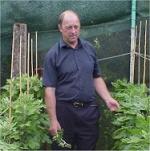Cultivation
Listed below are brief cultivation hints, a more detailed account of growing Late Chrysanthemums can be obtained by visiting the National Chrysanthemum Society web site. A book entitled Late Flowering Chrysanthemums written by myself can be obtained from the sales manager Barry Hogg. It is quite modestly priced.
Membership of the National Chrysanthemum Society is currently £22.00. Their 2 publications per year offer excellent value for money, each one packed with articles written by all the top growers, information on new varieties and are full of useful tips on how you can grow better chrysanthemums. Why not join today.
Contents
Care of stools
Rooting Cuttings
First potting
Second potting
| This is usually after 6 weeks (end of March early April) when the plants have filled the first pots with roots. Use the same compost formula but double the fertiliser. E.g. 8oz (226gms) per bushel. Do not increase the calcified seaweed. Follow the same watering regime as for the smaller pots. The plants can now move into cold frames, or if they are to remain in the greenhouse only frost protection will now be necessary. To protect the plants in cold frames against frost Bubble insulated polythene is ideal, roll it over the frames when frost is expected, and hold it down with a few loose boards. |
|
| Details of pot sizes and stopping dates are available here |
Final potting
| This is usually after another 6 weeks (mid May to mid June) when the plants have filled the second pots with roots. Use the same compost formula but treble the fertiliser. E.g. 12oz (339gms) per bushel. Do not increase the calcified seaweed. The plants can remain outside from now on, you can stand them close together in a sheltered spot until final potting is completed. |
|
| The Summer Standing Ground – Usually surrounded by posts and windbreak netting, the plants are lined in single rows 2’6” (75cm) apart. End of row posts should be driven into the ground, and straining wires tensioned between them, each pot should have a cane to support the plant and this should be clipped to the wire to avoid it being blown over later on when the plants grow tall. 1ft 6” (45cm) should be allowed between each plant. | |
| Feeding – I use a teaspoon of Vitax Q4 or Chempak Chrysanthemum Fertiliser per week until the buds appear (end July – Mid August) then I change to Chempak Chrysanthemum fertiliser number 2. If you find difficulty getting hold of Chempak Chrysanthemum Fertiliser but you are able to get Vitax Q4 then add 1lb of ammonium nitrate to 5lb of Vitax Q4 to raise the nitrogen level Stop feeding as the skin on the top of the bud (calyx) begins to split and show colour. |
|
| Counting down – Each plant will have been carrying 2 to 4 shoots (refer to Varieties on other page) as the buds appear cut off the spare breaks (stems) leaving the strongest one to carry one large bloom. | |
| Dis-budding – as the side shoots appear in the leaf axils they should be removed, the idea is to end up with the top bud (crown bud) left to give one large bloom. | |
| Bud Bags – 6 inch bud bags are useful to prevent rain and dew coming in contact with the developing petals, most growers put one bag inside another to make them stronger and more weather proof, double bagged. Bud should only remain in bud bags for a maximum of ten days. They will then need to be transferred to the greenhouse. These bags can be purchased from Paul Barlow his web site can be found by going to links and clicking Chrysanthemums in Aberdeen. |
|
| Flowering - This will be inside the greenhouse. I always empty and thoroughly clean the greenhouse, burn a sulphur candle overnight to kill any pests. I line the greenhouse with thin gauge polythene to prevent drips, and also shade with either a shading paint e.g. (Coolglass) or alternatively use muslin or garden fleece inside the polythene. It pays to spray the plants with a good insecticide and fungicide before bringing them into the greenhouse. | |
| Heating – I set my heater to 10oc (50of) and I ventilate at 12of by day. Rain should be prevented from coming through the top vents, side louvers are useful on days when rain is a possibility. | |
| Humidity – This is the worse problem during the flowering phase. I overcome this problem by running a de-humidifier from 5p.m. to 8a.m. when the humidity is a problem. The alternative to this is to hang an accurate hygrometer in the greenhouse and if the humidity raises above 90 % then you will have to turn the heater up until the humidity is below this figure. Failure to control the humidity will result in fungal infections on the petals (damping off) and a years work will be lost. |
|
| Watering – Try to keep the pots moist, drying out will ruin your blooms. Inspect the plants every morning and water any that show signs of drying out. |
Technical terms
| Stool – The base of an old plant from last season used to produce cuttings. | |
| Cuttings – Shoots from around the base of the old stool used as propagating material. | |
| Stopping – Removing the growing point, to produce side shoots. | |
| Lateral – A side shoot used to produce a flower. | |
| Break – Another word for a lateral. | |
| 1st Crown – A plant that is only stopped once and the resulting laterals allowed to flower. | |
| 2nd Crown – A plant that is stopped and the resulting laterals reduced to two, then stopped again, this delays flowering. | |
| Base fertiliser - Fertiliser containing the three major elements, nitrogen, phosphorus and potash and sometimes trace elements, used when preparing compost, and also used for feeding, applied to the compost and watered in | |
| Liquid feed – Soluble fertiliser. | |
| Feeding – Either applying a powdered base fertiliser or applying a soluble fertiliser when watering. | |
| Secure bud – Remove side shoots and buds, leaving only the central bud. | |
| Crown bud – The central bud. | |
| Ripe wood – Firm stems, by not over feeding or over watering and exposure to sunshine. | |
| Sport – A mutation, usually of a different colour but occasionally a different habit. | |
| Raised or Raiser – The breeder, by cross pollination, and selecting new seedlings and registering them as new cultivars. | |
| Released – The person that first offers a new cultivar for sale | |
| Cultivar – A name used to denote a new clone achieved by cross pollination, (man made) | |
| Variety – A natural cross often true breeding from seed (not man made) in the case of chrysanthemums the word cultivar is the correct term but variety is often used simply as a convenient term more easily understood by the layman. | |
| Irradiation – exposing cuttings to gamma irradiation to induce sports. | |
| Calyx – The thin skin over the top of the bud that protects the embryo petals until they develop. | |
| Register or Registered. - A record kept by the National Chrysanthemum Society (UK) all new cultivars must be registered and released before they are eligible to be exhibited and judged under National chrysanthemum society rules. (UK) | |
| Floral Committee – A group of experienced chrysanthemum growers appointed jointly by the National Chrysanthemum Society (UK) and The Royal Horticultural Society, for the purpose of registering new cultivars and giving awards to outstanding cultivars. |










